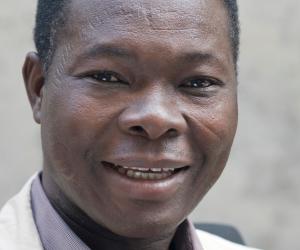First Published in
Architects design bridges. But sometimes they also need to be the bridge. A bridge between cultures, and a bridge between the technically and economically developed “West” and the developing global “South”.
Architect Francis Kéré is one such bridge, working tirelessly to translate Western-style architecture into a design and development narrative that works for the upliftment of urban communities in Africa. The passion, fervour and understanding with which Kéré does this had delegates at Design Indaba 2011 on their feet for a joyous standing ovation.
Born in Burkina Faso and educated at the Technische Universität in Berlin, Kéré works to apply the research he does on development strategies to benefit the communities of his home continent. For Kéré, it is about skills transfer as well as about adapting design technology from the developed world to make it climatically, architecturally and culturally suitable for Africa.
Climatic adaptation, low-cost buildings, local materials and community involvement characterise Kéré’s architectural undertakings in Africa, which include the Women’s Community Centre in Gando, Burkina Faso; the Museum and Centre for Communication in Mopti, Mali; numerous school projects in Burkina Faso; the National Park in Bamako, Mali; and an Opera Village in Laongo, Burkina Faso.
At the heart of Kéré’s creative philosophy is the belief that design should serve the real needs of the people, while taking care of the sustainability of the environment.
What are the most pressing challenges in urban development and housing in Africa at the moment?
There is a need to provide housing for everybody and to ensure safety in cities. We also need to look at the accessibility of cities and ways of improving access to public transport. I don’t like ghetto communities – public infrastructure in general needs to be addressed.
What are the key strategies that should be developed for the building of climatically advantageous structures in urban Africa?
First we must stop separating the hand from the brain. People that are going to be using a built structure should be involved in the project. We also need to consider more local materials. Energy and resources are limited, so when we remember this and plan from there, it will be easier to develop structures that are sustainable.
It’s important to use local materials and construction techniques. How can this be made to work alongside techniques and processes adapted from Western architecture?
We must not copy one-by-one but consider technological transfers. It starts with knowing what works and translating that to the needs of the local community. Communicate and understand the community, and then build a bridge. Like me, I learnt the technology in Germany and then went back to my village in West Africa where I passed on this new knowledge. We need to train and teach people how to use technology so that it can become beneficial to them.
How can technology really be applied to aid the sustainable development of urban centres in developing regions?
Technology is something that is merely the starting point. Technology gives the push. We don’t need to just be consumers. It’s about transforming technology to make it something for ourselves – it should not make us dependent on the West. We must get technology so that we can learn to make things ourselves.
What are the biggest misconceptions about development and climatic adaption in African countries?
Most of the time us Africans wait until people give us something. We think we must just be passive and wait. It is also wrong to simply reproduce Western architectural models, models made for the geographic north. If we just copy, we will get the wrong solutions; also because we’re asking the wrong questions.
In Africa we have a different way of living. It’s more open. And a different model, one that works in the African context, should take into account all these parameters. In Africa we have a different social and cultural background, and different needs. So we need our own kind of design. Africa needs a certain modernity but it can’t just copy from the West. Our climate is different and we must use more local materials.
Do you believe that the developing market can be the trendsetters for global, climatically advantageous architecture and design?
Yes! Why not? In Africa we’re at the beginning. Nothing has been built here yet but in Europe they’re fighting for the last bit of land. We have a chance here to consider the real needs of the user and the climate. We have also now learnt that we need to consider the climate. With our own buildings it’s about understanding the unique need of Africans, and the financial and environmental limitations we face. The world should be looking to Africa to see how to do it right. South Africa in particular can be a great model for the rest of Africa because the communication system is better developed here.
At Design Indaba you mentioned that Africans should develop their own identity in architecture. What do you think this identity should look like?
It should be considered innovative by the people. It should respond to the socio-cultural needs of the community, like that Africans like being “open” and outside in nature. It needs to prioritise the sense of community and neighbourliness that is so important in African culture. There should be shared, public spaces and it should work with the climate. Energy is expensive so Africans can’t afford aircon, meaning that their buildings should take this into consideration and be built accordingly. If you can design buildings and houses that respond to all of that, then you’re coming very close to an African design identity.














